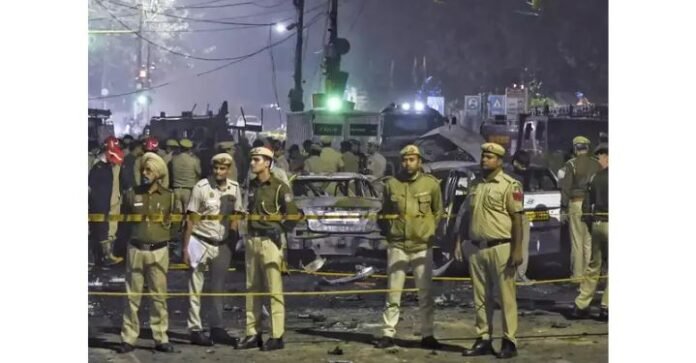Late Monday evening, a high-intensity explosion rocked a busy intersection near the historic Red Fort Metro Station in Delhi, leaving multiple casualties and prompting a swift response from both law-enforcement and civic authorities. In the aftermath, the Delhi Government under Chief Minister Rekha Gupta announced a relief package that aims to assist the families of the deceased and those grievously injured.
The Incident
The explosion occurred near Gate No. 1 of the Red Fort Metro Station, where a slow-moving vehicle came to a halt at a traffic signal and suddenly detonated. According to officials, a Hyundai i20 was involved, and initial reports suggest the blast may have been triggered intentionally, though investigations are ongoing. At least 12 people have been confirmed dead, and around 20 others were injured, including both serious and minor injuries. The blast also caused significant damage to nearby vehicles and infrastructure, underscoring the force of the explosion.
Relief Package Announced
In a post on X (formerly Twitter), Chief Minister Rekha Gupta offered condolences and announced the following ex-gratia payments:
- ₹10 lakh for each family of those who lost their lives.
- ₹5 lakh for individuals rendered permanently disabled in the blast.
- ₹2 lakh for those seriously injured.
Additionally, the government announced ₹20,000 for those who sustained minor injuries. Gupta affirmed that the government will ensure “proper and quality medical treatment” for all injured persons and that the departments concerned have been instructed to expedite relief payments.
Investigation Underway
The blast has triggered immediate action from multiple agencies. The Delhi Police registered an FIR under the Unlawful Activities (Prevention) Act (UAPA) and the Explosives Act, reflecting the gravity and suspected nature of the incident. CCTV footage has been seized and is being painstakingly reviewed; preliminary reports suggest the vehicle may have been stationary for some time before the blast occurred. The central National Investigation Agency (NIA) has taken over key portions of the probe.
Authorities are also considering whether the explosion was linked to a larger terror module. Reports indicate the recovery of a large cache of explosives—nearly 2,900 kg of suspected ammonium nitrate—from a location in Faridabad connected to a suspect module. According to officers, the blast may have occurred prematurely, potentially limiting the intended scale of damage; no puncture or shrapnel marks were found on many of the injured, which is unusual for a typical bomb blast.
Security and Public Response
Following the explosion, Delhi was placed on a heightened security footing. The Central Industrial Security Force (CISF) issued alerts across critical infrastructure nationwide—airports, metro stations, heritage sites and government buildings. Traffic and pedestrian movement around the Red Fort, Chandni Chowk and surrounding Old Delhi zones have been restricted as law-enforcement sweeps the area.
Eyewitnesses described devastation: the blast’s shock-wave reportedly shook windows up to two kilometres away, and body-parts, mangled vehicles and flames created scenes of horror. Amid the chaos, hospitals such as the Lok Nayak Jai Prakash Hospital received the injured, and relief and counselling resources are being mobilised.
Why This Matters
The Red Fort area is not just a heritage hub—it’s a densely populated, commercially vibrant zone with heavy foot-traffic and tourist presence. An incident here raises questions about the security of public-spaces long considered safe. Moreover, the swift announcement of compensation by the Delhi government reflects both a policy response to immediate tragedy and a recognition of the psychological toll on victims’ families and the wider city.
The relief package is significant: offering financial support sends a message of solidarity and responsibility. Yet, as Gupta herself acknowledged, no amount of compensation can truly make up for the loss of life or the trauma of injury.
What Happens Next
- Relief disbursement: The Delhi government has instructed departments to prioritise and expedite payments so that eligible families receive aid without delay.
- Ongoing investigation: With multiple agencies involved, including the NIA and FSL units, the probe aims to establish motive, modus operandi, vehicle origin, explosive source, and any accomplices.
- Security reviews: Delhi’s daily life will remain under close watch; security protocols will be reassessed, particularly for heritage zones, metro stations and crowded zones.
- Public reassurance: Authorities have pledged vigilance and caution to reassure the public. The chief minister’s message emphasises that maintaining peace and security in the capital is the “utmost priority.”
Final Thoughts
In the wake of the tragedy, grief and shock hang heavy over Delhi. The explosion near the Red Fort Metro Station has not only claimed lives and caused injuries—it has jolted a city long accustomed to navigating high-risk zones. The relief package announced by the Delhi government offers immediate financial support which, while necessary, underscores the deeper vulnerability of public spaces and community safety. As investigations deepen and security frameworks tighten, the human cost remains central: for the families of the deceased and those permanently disabled, life has irrevocably changed.
The coming days will test how effectively the relief reaches victims, how transparently the investigation proceeds, and how the city re-establishes a sense of normalcy without complacency. But for now, the promise of support is a vital first step in the path toward recovery and accountability.

